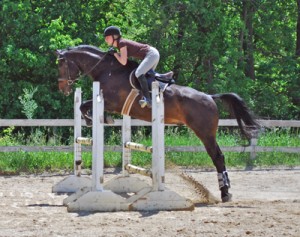 After reading Berger and Walker, I have begun to think of holding a horse in captivity for recreational purposes in a different light. The image that I have selected, shown above, depicts a competitive rider forcing a horse to jump over an obstacle. This image comes from the Chestnut Hill Farm website which is a farm that offers equestrian lessons. It appears that the horse is her property and that the rider is the slave-owner whereas the horse is her slave. This image glorifies the sport of competitive riding. The assumption is that the purpose of the horse is for the control of the rider. The better control the rider has of the horse, the more successful the rider is considered. After reading Walker’s essay, I noticed the firm grip that this woman has on the reins of the horse. That is not something that I would have noticed before and I wonder if it is an indicator of the power struggle between her and the horse.
After reading Berger and Walker, I have begun to think of holding a horse in captivity for recreational purposes in a different light. The image that I have selected, shown above, depicts a competitive rider forcing a horse to jump over an obstacle. This image comes from the Chestnut Hill Farm website which is a farm that offers equestrian lessons. It appears that the horse is her property and that the rider is the slave-owner whereas the horse is her slave. This image glorifies the sport of competitive riding. The assumption is that the purpose of the horse is for the control of the rider. The better control the rider has of the horse, the more successful the rider is considered. After reading Walker’s essay, I noticed the firm grip that this woman has on the reins of the horse. That is not something that I would have noticed before and I wonder if it is an indicator of the power struggle between her and the horse.
I found Walker’s analogy between animal captivity and historical slavery interesting and wondered how it could apply to this image. After reading Walker’s work, when I look at this picture I think about what the horse may be feeling or what may be going through the horse’s mind. Previously, I would not have focused on the horse or even thought how the horse may be emotionally affected by being held captive for the purpose of being ridden. After reading Berger and Walker, I find myself viewing this image from the animal’s point of view which has raised several questions for me.
The horse has been reduced and marginalized in order to fulfill the rider’s recreational needs. This is comparable to Berger’s ideas about how we reduce and marginalize animals by keeping them in zoos for our own entertainment. This interpretation of the image is different from how I previously viewed equestrianism. I used to think that it was exciting and fun. I even considered it something that I was interested in doing because I love horses. However, after reading Berger I realized that truly loving an animal does not involve marginalizing that animal. Berger’s view that capitalism is a large cause behind the reason we view animals for their instrumental value struck me and made me wonder if that idea could be applicable to the mission of Chestnut Hill Farms. Chestnut Hill is capitalizing on the horse’s majestic nature by making the sport look beautiful and graceful in this image. The image is focusing on the instrumental value of the horse while completely ignoring its intrinsic value.
Often, we treat animals the way we treat human beings in many aspects. My interpretation of this image human-animal relationships after reading Berger and Walker caused me to think about human-human relationships in a similar context. For example, human slaves were sold as gladiators during Ancient Roman times for the entertainment of the people. Similarly, animals such as horses are being sold for recreational purposes as well. Berger and Walker have gotten me thinking about whether keeping animals (both human and non-human) captive for recreational purposes is ethical. It also raised the difficult question of whether it is possible to have an animal as a pet and still give it full life. This is a question I have begun thinking about after reading Berger and Walker but have still not come up with an answer to because I do not believe that there is one simple answer to this question. I believe that the ability to give a pet full life has to do with how the animal is treated as well as if the owner views the animal for its intrinsic or instrumental value.
References:
Chestnut Hill Farm, 2014. Web. 10 Sept. 2014.
John Berger. “About Looking”. Pantheon Books, 1980. Print.
Walker, Alice. “Am I Blue.” Human Rights Anthology. Ed. Lee Peralta. New York: Columbia U. Press, 1995. 438-445. Print.
Leave a Reply